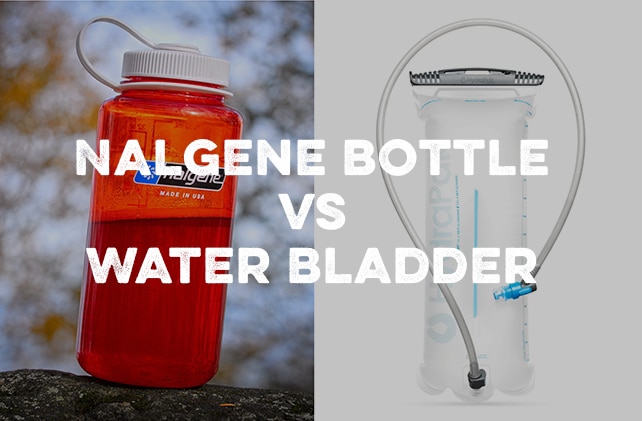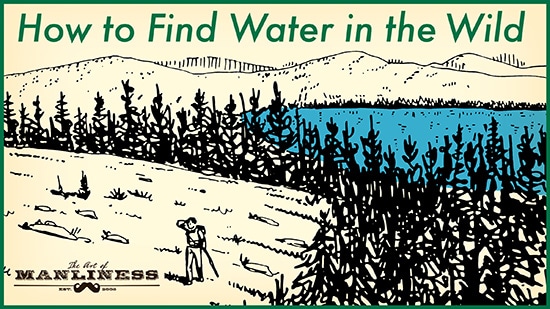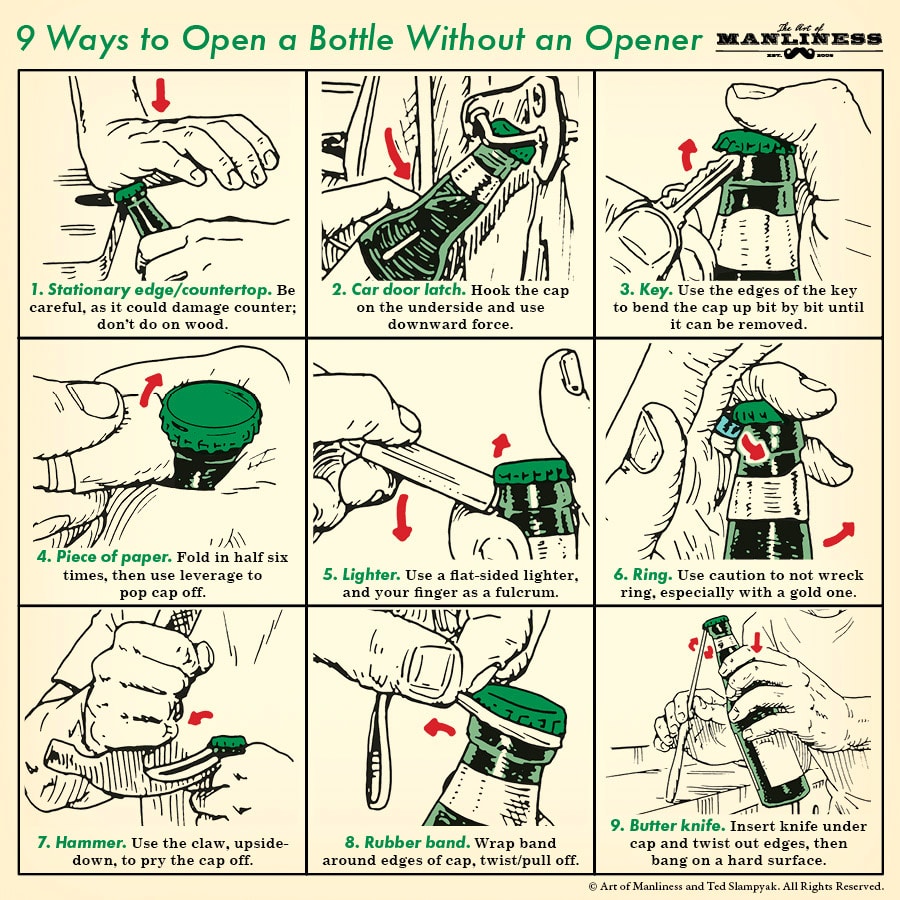
It’s indisputable that hydration is a top priority when you’re hiking or backpacking.
More debatable is the best way to carry the water that makes that hydration possible.
There are two main ways to carry water in the outdoors: in a bladder/reservoir or in a bottle — often a Nalgene bottle.
Each of these water-carrying methods has its fans and its particular pros and cons. Today we’ll highlight the areas where the bladder and the Nalgene bottle respectively have the advantage, so you can decide which to use on your next trek into the wilds.
Weight
Two liters is a standard amount of water to carry in the outdoors (if you’re going somewhere where water sources are few and far between, you may want to carry three).
A water reservoir holds two liters while weighing itself only around 5-7 ounces.
To carry about two liters (you’ll still be short a couple ounces) with Nalgenes, you’d need to carry two 32-ounce-capacity bottles, which together weigh in at nearly a pound.
So when packing light is a priority, carrying a bladder is the way to go.
Advantage: Bladder
Carry-ability
You may want to consider not just the weight of your water, but how that weight is carried.
Backpacks often come with an interior pocket in which to place your reservoir. This pocket puts the bladder closer to your body and in a mid-to-high position in your pack, which is the optimum position for a heavier item, which water certainly is.
However, some people feel like putting their Nalgene bottles in the bottle-holder pockets on each side of their pack places more of the water weight on the pack’s frame, which they like. Keeping this weight balanced will, of course, require drinking from each bottle in equal measure, a consideration you may not want to deal with.
How much room each storage system takes up is something else to think about. A bladder initially takes up more of the interior space in your pack. But as you drink from it, it collapses in size. Nalgene bottles take up the same amount of space whether empty or full. But as you’re likely carrying them on the exterior of your pack, you may not care.
Overall, there’s not a definitive winner in this category.
Advantage: Draw
Accessibility and Handiness While Hiking
Reaching back to retrieve a Nalgene bottle that’s stored in a pack’s exterior bottle pockets can be difficult to impossible. So when you need to take a drink, you have to stop and remove your pack or ask a companion to hand the bottle to you. Even when you get the bottle out, you still need to unscrew the cap and take a sip from its awkwardly wide mouth — something you’ll struggle to do while walking at the same time. Because drinking from a Nalgene requires pausing to make it a dedicated activity, you may end up drinking less than is ideal.
With a water bladder, on the other hand, your drinking tube and bite valve hang outside your pack, allowing you to grab it and take sips of water whenever you want, including as you hike. Bladders let you hydrate on the move.
Nalgene bottles do have a benefit in allowing you to see how much water you’ve already consumed (to ensure you’re drinking enough) and how much water you have left (the fact you’ve reached the bottom of a reservoir can come as an unexpected and unpleasant surprise). So too, some people like to be able to gulp their water when they want, and find it tedious to have to constantly draw little sips from their reservoir. Overall, though, the accessibility and ease of drinking from a bladder represent a real point of superiority. So much so, that many folks feel it outweighs the importance of all other factors.
Advantage: Bladder
Accessibility and Handiness at Camp
If the bladder really shines while you’re on the move, the Nalgene proves its worth once you make camp.
While the bladder lies on the ground like a shapeless slug, as your bite valve gets covered in dirt and pine needles, a Nalgene stands upright and is easy to tote around camp.
It’s also easier to pour water out of a Nalgene in order to wet a toothbrush, rinse your hands, or cook. A Nalgene is handy for that latter category too because it has easy-to-use measurements right on the bottle.
You can also fill up a Nalgene with hot water and put it in your sleeping bag to keep you warm as you slumber.
Finally, a Nalgene is slower to freeze than a bladder; it’s a real booger to arise in the morning only to find that the hose of your reservoir has frozen up.
Advantage: Nalgene
Refilling
Whether a bladder or Nalgene is easier to refill from an outdoor water source depends on how you filter your water.
If you’re using something like a SteriPEN or a purification tablet and will be drawing your water right from the source, then the Nalgene is the winner. It’s easier to dip it into even the shallowest of depressions.
But if you’re filtering your water with a pump filter, refilling a bladder can be easier than refilling a bottle. You often just connect the filter hose directly into the tube connector of your water bladder and start pumping. Refilling a Nalgene bottle with a pump filter is a little trickier, as you have to keep the filter tube in the bottle as you pump. Pump filters sometimes come with an attachment that secures the tube inside the bottle, which makes things easier, but you still have to keep your Nalgene upright as you pump.
Advantage: Draw
Durability/Reliability
While water bladders have improved in durability and reliability since they were first introduced, and many can last for years without any issues, some can spring leaks or pop. If, unbeknownst to you, your bladder is leaking in your pack, and gets your clothes and sleeping bag all wet, that can be a real disaster. So can your reservoir bursting if you don’t have a backup water vessel from which to drink.
Nalgene bottles aren’t indestructible, but they’re pretty supremely durable. There’s almost no chance of their breaking while you’re out on a hike, providing ample peace of mind.
Advantage: Nalgene
Cleaning
There’s no real consensus on how often you need to clean a water reservoir. If you put a sugary drink in it, you definitely should clean it after every use; sugar breeds mold. If you’re only carrying water and are using it regularly, you can get away with just rinsing it between uses. Beyond that, you’ll see recommendations that you give it a good clean anywhere from twice a month to twice a year, and definitely before you put it away for longer-term storage.
However often you clean it, when you do perform this chore, it’s a big pain in the butt. You’ve got to detach all the parts and then clean the bladder, the hose, and the various pieces of the bite valve separately. Then you’ve got to let those pieces dry, which isn’t always easy with the bladder itself, as its top seals closed unless you do something to manually wedge it open (like put it over another object or insert a jerry-rigged clothes hanger). Bladder makers sell whole kits to help you accomplish this cleaning job, and people have all kinds of elaborate regimens they employ, from rinsing it with bleach, baking soda, vinegar, or denture tablets, to drying the inside with paper towels, to storing the bladder in the freezer (so mold won’t grow). There are bladders like the HydraPak, which can be turned inside out, making cleaning easier. But even then, cleaning all its pieces remains a pain in the butt.
Oh, and even after you’ve done all that cleaning, sometimes your water still tastes like plastic.
With a Nalgene, there are no nooks and crannies for nastiness to fester, and no little pieces to keep clean. Just throw it in the dishwasher and you’re done.
Advantage: Nalgene
Conclusion
Whether you choose to carry your water in a reservoir or a Nalgene bottle will depend on which of the above categories count for more or less with you. It can also depend on the situation you find yourself in. A bladder can be best for hot environments, when the importance of staying well hydrated, and thus the ease of drinking, trumps other considerations. The Nalgene might be your go-to for cold-weather trips, when you don’t want to risk your reservoir freezing up.
And, of course, you can carry both: a bladder for on-the-go drinking and a Nalgene for backup/use around camp. Or the bladder for water and the Nalgene for flavored drinks. If you don’t want to carry the weight of a Nalgene, there are light, collapsible bottles that can serve as a backup, or just bring along a disposable bottle. Of course, those options don’t come with the possibility of transforming the vessel into a hot water bottle, and to what will you affix the sticker you get to commemorate your trip?







